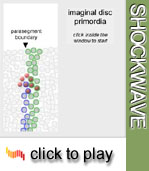Embryonic disc primordia
 These
obersevations have to date been confirmed for the thoracic imaginal discs
through experiments using molecular markers. Imaginal discs arise as a cluster
of Distalless (Dll) expressing cells on the parasegmental
boundary, at the ends of the ventromedial wingless (wg) stripe.
wg is required in a narrow time window for the onset of Dll
expression which is then maintained in an autoregulatory loop. At stage
11, decapentaplegic (dpp) is expressed in the dorsalmost cells
of the cluster. dpp contributes to the specfication of cells within
the presumptive disc. It is responsible for the expression of vestigal
in the presumptive wing disc cells, which then separate from the leg disc.
These
obersevations have to date been confirmed for the thoracic imaginal discs
through experiments using molecular markers. Imaginal discs arise as a cluster
of Distalless (Dll) expressing cells on the parasegmental
boundary, at the ends of the ventromedial wingless (wg) stripe.
wg is required in a narrow time window for the onset of Dll
expression which is then maintained in an autoregulatory loop. At stage
11, decapentaplegic (dpp) is expressed in the dorsalmost cells
of the cluster. dpp contributes to the specfication of cells within
the presumptive disc. It is responsible for the expression of vestigal
in the presumptive wing disc cells, which then separate from the leg disc.Media list
Genes discussed
|
Gene
|
Gene product
- Domains
|
Function
|
Links
|
|
decapentaplegic (dpp)
|
ligand - TGF-ß homolog
|
Dpp establishes the dorsal / ventral pattern and defines
compartment boundaries
|
|
|
Distal-less (Dll)
|
transcription factor - homeodomain
|
defines the termini of appendages and regulates
appendage growth
|
|
|
engrailed (en)
|
transcription factor - homeodomain
|
segment polarity gene - involved in compartment
identity and boundary formation
|
|
| escargot (esg) | transcription factor - zinc finger | transcriptional repressor, regulates cell cycle | Interactive Fly |
|
vestigial (vg)
|
presumptive transcription factor - novel
|
the activation of several genes in the wing field
requires Vg/Sd function, for example activation of Serum response
factor intervein promoter
|
|
|
wingless (wg)
|
ligand - wnt family
|
segment polarity gene, intercellular signaling protein
|